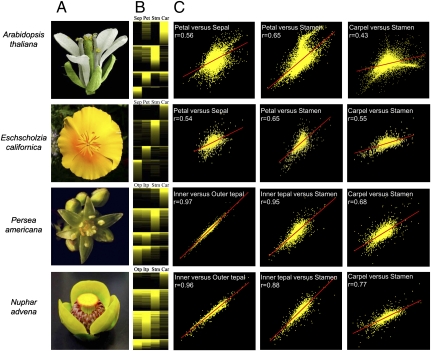Fig. 2.
Canalization of floral organ transcriptional programs during angiosperm diversification. (A) Flowers of Nuphar and Persea bear an undifferentiated perianth of petaloid organs (tepals), whereas in Eschscholzia and Arabidopsis flowers the perianth is differentiated into leaf-like outer sepals and colorful inner petals. (B) Log2 floral organ/leaf gene expression ratios ranked by organs of peak expression contrast the blurred boundaries between adjacent floral organs in Nuphar and Persea versus the sharp boundaries in Arabidopsis and Eschscholzia. Stamen-preferential genes generally are more broadly expressed, but more so in Nuphar and Persea than in the eudicots, whereas carpel-preferential genes generally are more spatially restricted. Car, carpels; Itp, inner tepals; Otp, outer tepals; Pet, petals; Sep, sepals; Stm, stamens. The scale of log2 ratios ranges from saturated yellow (1 and higher = at least twofold up-regulated) to black (0 and lower = no change or down-regulated). (C) Scatter plots of log2 floral organ/leaf ratios and Pearson correlations indicate that transcriptional profiles of adjacent floral organs are more strongly correlated in Nuphar and Persea than in eudicots. Analyses are based on 4,588 Nuphar, 4,508 Persea, 5,468 Eschscholzia, and 12,785 Arabidopsis genes up-regulated in their respective flowers relative to leaves.

